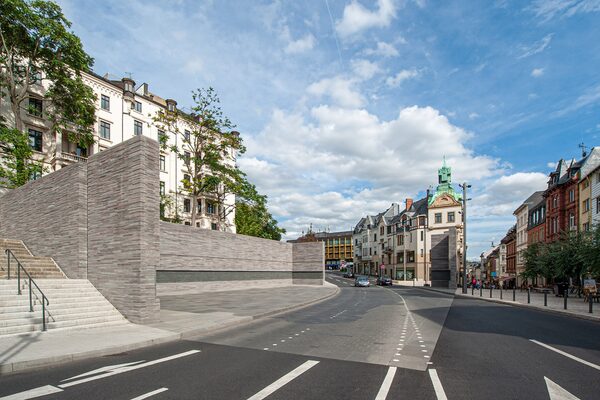Michelsberg memorial for the murdered Jews of Wiesbaden
The memorial to the murdered Jews of Wiesbaden was handed over to the citizens on January 27, 2011. It stands on the former site of the old Wiesbaden synagogue. The central component of the memorial is the volume of names, which lists the names of 1,547 Wiesbaden Jews murdered in the Shoah.
Memorial site on the Michelsberg
In 2006, the city council decided to hold an urban planning ideas competition for the redesign of the Michelsberg area. The aim was to create a dignified place to commemorate all Wiesbaden Jews murdered during the National Socialist dictatorship. Previously, a pillar and three plaques on Michelsberg, the former site of the synagogue of the Jewish Community, commemorated the destruction of the building in the November pogroms of 1938. The Heinrich Heine site was created here in 1953, where the stele created by sculptor Egon Altdorf, which is now located at the entrance to Schulberg, was erected in memory of the Nazi crimes. In 1969, the former site of the synagogue was built over with an elevated road to make Wiesbaden's city center more car-friendly. The Heinrich-Heine-Anlage had to be relocated and cars now drove through the middle of the former synagogue area. Hochstrasse stood until it was demolished in 2001.
Since 1954, the former site of the synagogue has been the place where the Jewish community of Wiesbaden and the Society for Christian-Jewish Cooperation Wiesbaden commemorate the destruction of synagogues in Germany during the November pogroms of 1938 every year on November 9. A few years later, the state capital of Wiesbaden joined the Jewish community and the Society for Christian-Jewish Cooperation as a co-organizer. In addition to the annual commemorative event, initiatives began to address the authentic site and called for the establishment of a memorial. These included a group of students and teaching staff from the interior design course at RheinMain University of Applied Sciences, who came together under the name "memo38" in spring 1998. Their aim was to virtually reconstruct the old synagogue, which was destroyed in 1938, with the help of 3D computer animations. The magnificent building, erected in Moorish style by Philipp Hoffmann in 1869, was the center of Jewish life in Wiesbaden. The virtual reconstruction created under the direction of Edgar Brück was groundbreaking both technically and in terms of commemorative work. The computer animation can be seen in the Remembrance Room. In 2021, the Jewish Community of Wiesbaden worked together with the Wiesbaden City Archive to reconstruct the old synagogue as augmented and virtual reality as part of the project "Gesher - Change of Perspective 1869 / 1938 / 1946".
The history of the Old Synagogue on Michelsberg
The memorial for the murdered Jews of Wiesbaden
Following the demolition of the elevated bridge in 2001, there was a discussion about the further use of the Michelsberg site. In spring 2006, the state capital of Wiesbaden launched an urban/open space planning ideas competition. The aim was to redesign the "Former Synagogue / Michelsberg" area and to commemorate by name the Jews of Wiesbaden who were murdered by the Nazi regime.
The competition entry by the consortium "barbara willecke planung - freiraum mit Reinhard Angelis und Valeria Sass" was awarded first prize. Based on these plans, construction work began on the "Wiesbaden Memorial by Name" in April 2010. The memorial to the murdered Jews of Wiesbaden was realized according to the plans of Berlin landscape architect Barbara Willeke by Stadtentwicklungsgesellschaft Wiesbaden. The central feature is the memorial by name, which, in the form of a circumferential band of names, lists the names, dates of birth and death as well as the places of birth and death of the Wiesbaden Jews murdered in the Shoah, where these can be determined. By 2011, 1,507 names had been researched. In 2023, a further 42 name stones were added. There are now 1,549 names on the ribbon of names. All names and the documentation created on the occasion of the handover to the citizens in 2011 have been available online since 2023.
The biographical data of those murdered was researched by the city archive in cooperation with the Aktives Museum Spiegelgasse für Deutsch-Jüdische Geschichte Wiesbaden e.V. (Active Museum Spiegelgasse for German-Jewish History Wiesbaden). The volume of names is supplemented by "memorial sheets" compiled by the Active Museum. They tell the very personal stories and fates of the murdered Jews of Wiesbaden.
The concept of the memorial comprises two corresponding areas divided by the street layout. They visualize the empty space in the cityscape created by the destruction of the synagogue. The ground plan of the old synagogue is incorporated into the floor of the memorial. The wall elements mark the outline of the platform on which the building stood until its destruction in 1938. The main entrance to the synagogue was on the west side. The memorial picks up on this with a glass insert on which a photograph of the interior of the synagogue can be seen. An information board with a touchscreen provides further information about the authentic site in German and English. This information can also be called up at the touch of a button at an audio station. There is also a QR code on the information board to call up the synagogue model as augmented reality.
Further information
Contact us
City archive
Address
65197 Wiesbaden
Postal address
65029 Wiesbaden
Arrival
Notes on public transport
Public transportation: Bus stop Kleinfeldchen/Stadtarchiv, bus lines 4, 17, 23, 24 and 27 and bus stop Künstlerviertel/Stadtarchiv, bus line 18.
Telephone
- +49 611 313022
- +49 611 313977
Opening hours
Opening hours of the reading room:
- Monday: 9 a.m. to 12 p.m.
- Tuesday: 9 am to 4 pm
- Wednesday: 9 am to 6 pm
- Thursday: 12 to 16 o'clock
- Friday: closed
